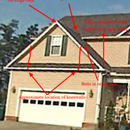Conditioned attic and kneewall
Hello all,
Forgive the long post. I’m likely overthinking this, so any expert advice would be appreciated. I’m considering application of open cell spray foam to my roof deck. My home is in North Carolina (zone 4A near 3A) and has HVAC in the attic. Can you offer some advice on how to apply foam to the kneewall area in the bonus room above my garage. The garage has a portion of gable end in order to provide depth for vehicle parking. The gable end area has kneewalls with small (16″ x32″) accees doors of 3/4″ plywood. The soffits are ventilated and batt insulation is installed in the rafter bays. Note there is no ridge vent and the ridge beam and first rafter bay is visible from the main attic. I assume this provides a minor amount of ventilation for those first few rafter bays near the main attic but certainly not those further away which are effectively boxed in by roof deck, batt insulation and drywall. Ideally, I would like to include spray foam in those areas behind the knee wall (roof deck and exterior wall) to air seal and bring the access into the conditioned environment. If spray foam is applied to the main attic roof deck, then the minor amount of ventilation provided there the would be sealed. Is this a valid concern?
As I see it there are a couple of options:
1. Spray foam main attic, spray foam knee wall area. The rafter bay area effectively sealed now with only minor air leakage between bays for ventilation. I’m not aware of any mold/moisture/condensation problems related to soffit air entering the area. Since open cell foam is moisture permeable, I would think any moist/humid air in those rafter bays would be able to find its way out of the space.
2. Foam main attic, provide air channel under roof deck in kneewall area and spray foam knee wall area. Install ridge vent on gable roof over kneewall area.
3. Spray foam main attic, spray foam knee wall area. Remove drywall above kneewalls and spray foam rafter bays.
I have attached a photo if it helps illustrate. Thanks in advance for your input.
GBA Detail Library
A collection of one thousand construction details organized by climate and house part










Replies
First of all, can you tell us your name? (I'm Martin.)
If you are converting your vented attic to a conditioned attic (because your HVAC equipment is in your attic), then by definition you are sealing up the vents. This type of attic doesn't need soffit vents, and it doesn't need ridge vents.
For more information on creating an unvented conditioned attic, see "Creating a Conditioned Attic."
The use of open-cell spray foam for this purpose is somewhat risky -- closed-cell spray foam is preferred. For more information, see "High Humidity in Unvented Conditioned Attics."